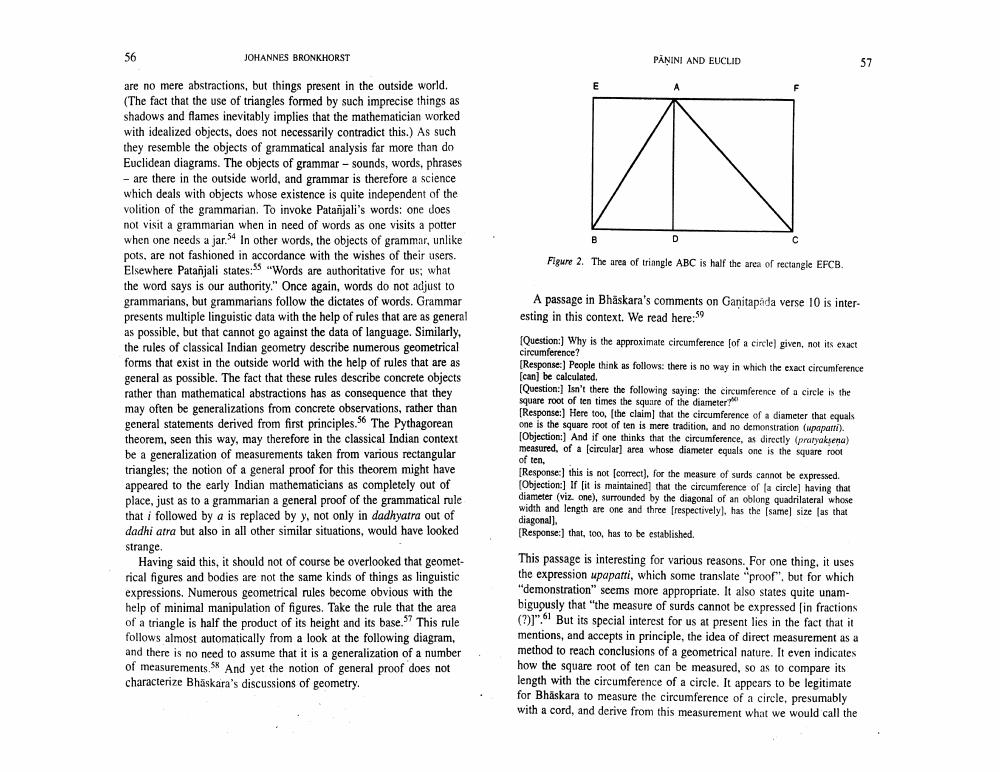Book Title: Panini And Euclid Reflections On Indian Geometry Author(s): Johannes Bronkhorst Publisher: Johannes Bronkhorst View full book textPage 8
________________ JOHANNES BRONKHORST PĀŅINI AND EUCLID Figure 2. The area of triangle ABC is half the area of rectangle EFCB. A passage in Bhaskara's comments on Ganitapada verse 10 is interesting in this context. We read here:59 are no mere abstractions, but things present in the outside world. (The fact that the use of triangles formed by such imprecise things as shadows and flames inevitably implies that the mathematician worked with idealized objects, does not necessarily contradict this.) As such they resemble the objects of grammatical analysis far more than do Euclidean diagrams. The objects of grammar - sounds, words, phrases - are there in the outside world, and grammar is therefore a science which deals with objects whose existence is quite independent of the volition of the grammarian. To invoke Patanjali's words: one does not visit a grammarian when in need of words as one visits a potter when one needs a jar. In other words, the objects of grammar, unlike pots, are not fashioned in accordance with the wishes of their users. Elsewhere Patanjali states: "Words are authoritative for us; what the word says is our authority." Once again, words do not adjust to grammarians, but grammarians follow the dictates of words. Grammar presents multiple linguistic data with the help of rules that are as general as possible, but that cannot go against the data of language. Similarly, the rules of classical Indian geometry describe numerous geometrical forms that exist in the outside world with the help of rules that are as general as possible. The fact that these rules describe concrete objects rather than mathematical abstractions has as consequence that they may often be generalizations from concrete observations, rather than general statements derived from first principles. The Pythagorean theorem, seen this way, may therefore in the classical Indian context be a generalization of measurements taken from various rectangular triangles; the notion of a general proof for this theorem might have appeared to the early Indian mathematicians as completely out of place, just as to a grammarian a general proof of the grammatical rule that i followed by a is replaced by y, not only in dadhyatra out of dadhi atra but also in all other similar situations, would have looked strange Having said this, it should not of course be overlooked that geometrical figures and bodies are not the same kinds of things as linguistic expressions. Numerous geometrical rules become obvious with the help of minimal manipulation of figures. Take the rule that the area of a triangle is half the product of its height and its base." This rule follows almost automatically from a look at the following diagram, and there is no need to assume that it is a generalization of a number . of measurements 5* And yet the notion of general proof does not characterize Bhaskara's discussions of geometry. [Question:) Why is the approximate circumference for a circle given, nor its exact circumference? (Response:) People think as follows: there is no way in which the exact circumference (can] be calculated [Question:] Isn't there the following saying the circumference of a circle is the square root of ten times the square of the diameter [Response) Here too, the claim that the circumference of a diameter that equals one is the square root of ten is mere tradition, and no demonstration (papani). [Objection:) And if one thinks that the circumference, as directly prutyakena) measured, of a circular) area whose diameter equals one is the square root of ten, [Response) this is not correct), for the measure of surds cannot be expressed (Objection:) If it is maintained that the circumference of a circle] having that diameter (viz one), surrounded by the diagonal of an oblong quadrilateral whose width and length are one and three frespectivelyl. has the same size (as that diagonal). Response:) that, too, has to be established. This passage is interesting for various reasons. For one thing, it uses the expression upaparti, which some translate "proof", but for which "demonstration" seems more appropriate. It also states quite unambiguously that "the measure of surds cannot be expressed in fractions (7)". But its special interest for us at present lies in the fact that it mentions, and accepts in principle, the idea of direct measurement as a method to reach conclusions of a geometrical nature. It even indicates how the square root of ten can be measured, so as to compare its length with the circumference of a circle. It appears to be legitimate for Bhaskara to measure the circumference of a circle, presumably with a cord, and derive from this measurement what we would call thePage Navigation
1 ... 6 7 8 9 10 11 12 13 14 15 16 17 18 19 20
